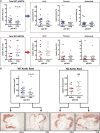p53 is required for chloroquine-induced atheroprotection but not insulin sensitization
- PMID: 20208057
- PMCID: PMC2882736
- DOI: 10.1194/jlr.M003681
p53 is required for chloroquine-induced atheroprotection but not insulin sensitization
Abstract
An intact genotoxic stress response appears to be atheroprotective and insulin sensitizing. ATM, mutated in ataxia telangiectasia, is critical for the genotoxic stress response, and its deficiency is associated with accelerated atherosclerosis and insulin resistance in humans and mice. The antimalarial drug chloroquine activates ATM signaling and improves metabolic phenotypes in mice. p53 is a major effector of ATM signaling, but it is unknown if p53 is required for the beneficial effects of chloroquine. We tested the hypothesis that the cardiometabolic effects of chloroquine are p53-dependent. ApoE-null mice with or without p53 were treated with low-dose chloroquine or saline in the setting of a Western diet. After 8 weeks, there was no p53-dependent or chloroquine-specific effect on serum lipids or body weight. Chloroquine reduced plaque burden in mice wild-type for p53, but it did not decrease lesion extent in p53-null mice. However, chloroquine improved glucose tolerance, enhanced insulin sensitivity, and increased hepatic Akt signaling regardless of the p53 genotype. These results indicate that atheroprotection induced by chloroquine is p53-dependent but the insulin-sensitizing effects of this agent are not. Discrete components of the genotoxic stress response might be targeted to treat lipid-driven disorders, such as diabetes and atherosclerosis.
Trial registration: ClinicalTrials.gov NCT00455325 NCT00455403.
Figures






Similar articles
-
Targeting lysosomal degradation induces p53-dependent cell death and prevents cancer in mouse models of lymphomagenesis.J Clin Invest. 2008 Jan;118(1):79-88. doi: 10.1172/JCI33700. J Clin Invest. 2008. PMID: 18097482 Free PMC article.
-
Starvation-induced activation of ATM/Chk2/p53 signaling sensitizes cancer cells to cisplatin.BMC Cancer. 2012 Dec 4;12:571. doi: 10.1186/1471-2407-12-571. BMC Cancer. 2012. PMID: 23211021 Free PMC article.
-
Functional interaction of H2AX, NBS1, and p53 in ATM-dependent DNA damage responses and tumor suppression.Mol Cell Biol. 2005 Jan;25(2):661-70. doi: 10.1128/MCB.25.2.661-670.2005. Mol Cell Biol. 2005. PMID: 15632067 Free PMC article.
-
p53: guardian of the genome and policeman of the oncogenes.Cell Cycle. 2007 May 2;6(9):1006-10. doi: 10.4161/cc.6.9.4211. Epub 2007 May 28. Cell Cycle. 2007. PMID: 17457049 Review.
-
Banking on ATM as a new target in metabolic syndrome.Cell Metab. 2006 Nov;4(5):337-8. doi: 10.1016/j.cmet.2006.10.009. Cell Metab. 2006. PMID: 17084707 Review.
Cited by
-
Expanding horizons for clinical applications of chloroquine, hydroxychloroquine, and related structural analogues.Drugs Context. 2019 Nov 25;8:2019-9-1. doi: 10.7573/dic.2019-9-1. eCollection 2019. Drugs Context. 2019. PMID: 31844421 Free PMC article. Review.
-
Impaired insulin-stimulated glucose transport in ATM-deficient mouse skeletal muscle.Appl Physiol Nutr Metab. 2013 Jun;38(6):589-96. doi: 10.1139/apnm-2012-0175. Epub 2012 Dec 20. Appl Physiol Nutr Metab. 2013. PMID: 23724874 Free PMC article.
-
Low dose chloroquine decreases insulin resistance in human metabolic syndrome but does not reduce carotid intima-media thickness.Diabetol Metab Syndr. 2019 Jul 29;11:61. doi: 10.1186/s13098-019-0456-4. eCollection 2019. Diabetol Metab Syndr. 2019. PMID: 31384309 Free PMC article.
-
Effects of low-dose hydroxychloroquine on expression of phosphorylated Akt and p53 proteins and cardiomyocyte apoptosis in peri-infarct myocardium in rats.Exp Clin Cardiol. 2013 Spring;18(2):e95-8. Exp Clin Cardiol. 2013. PMID: 23940455 Free PMC article.
-
Chloroquine increases phosphorylation of AMPK and Akt in myotubes.Heliyon. 2016 Mar;2(3):e00083. doi: 10.1016/j.heliyon.2016.e00083. Heliyon. 2016. PMID: 27047993 Free PMC article.
References
-
- Malik S., Wong N. D., Franklin S. S., Kamath T. V., L'Italien G. J., Pio J. R., Williams G. R. 2004. Impact of the metabolic syndrome on mortality from coronary heart disease, cardiovascular disease, and all causes in United States adults. Circulation. 110: 1245–1250. - PubMed
-
- Kastan M. B. 2008. DNA damage responses: mechanisms and roles in human disease: 2007 G.H.A. Clowes Memorial Award Lecture. Mol. Cancer Res. 6: 517–524. - PubMed
-
- Houstis N., Rosen E. D., Lander E. S. 2006. Reactive oxygen species have a causal role in multiple forms of insulin resistance. Nature. 440: 944–948. - PubMed
-
- Van Gaal L. F., Mertens I. L., De Block C. E. 2006. Mechanisms linking obesity with cardiovascular disease. Nature. 444: 875–880. - PubMed
Publication types
MeSH terms
Substances
Associated data
Grants and funding
LinkOut - more resources
Full Text Sources
Medical
Research Materials
Miscellaneous

